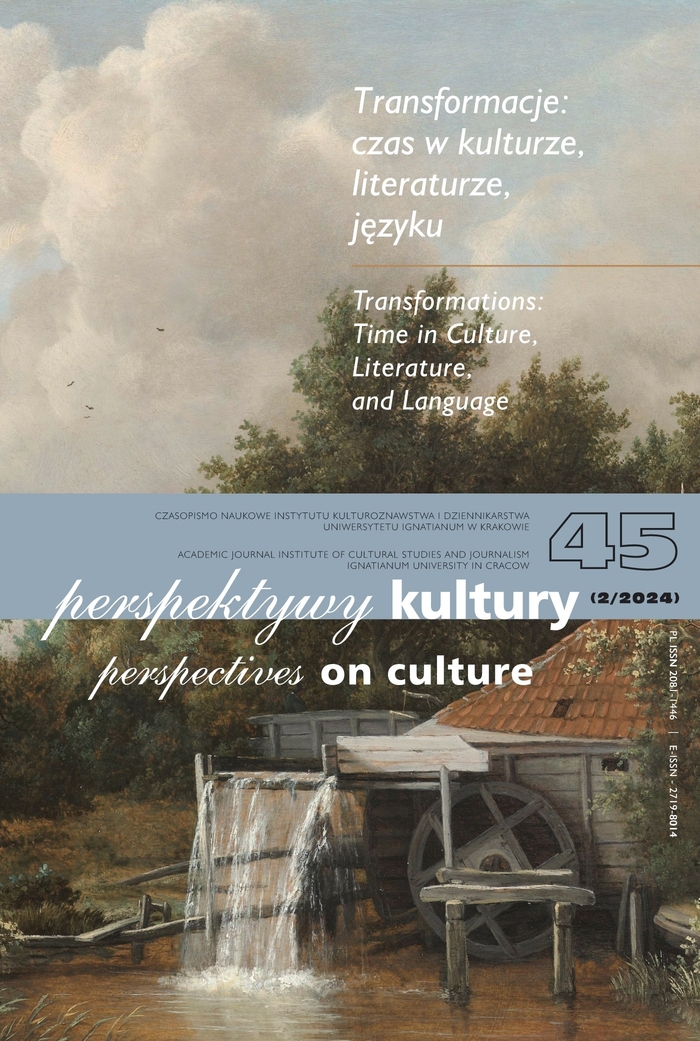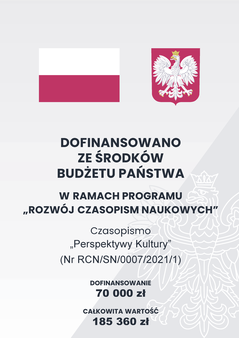The Septuagint – an ancient translation with an impact spanning over two millennia
Abstrakt
Artykuł omawia wybrane aspekty kulturotwórczej roli Septuaginty na przestrzeni wieków. Po krótkiej charakterystyce tego greckiego tłumaczenia Biblii hebrajskiej i prezentacji jego genezy (zarówno legendarnej jak i faktycznej) przedstawiona została jej rola jako tekstu fundacyjnego dla chrześcijaństwa oraz niektóre ślady jej wpływu widoczne w kulturze europejskiej po dzień dzisiejszy. W konkluzji stwierdzono że Septuaginta to „największy przekład wszechczasów”, który odcisnął trwałe piętno na zachodniej cywilizacji
Bibliografia
Augustine (1998). The City of God against the Pagans. Translated by R. W. Dyson. Cambridge: Cambridge University Press.
Augustine (1961). Confessions. Translated by R. S. Pine-Coffin. Harmondsworth: Penguin.
Badiou, A. (2003). Saint Paul: The Foundation of Universalism. Translated by R. Brassier. Stanford, CA: Stanford University Press.
Brock, S. P. (1972). The Phenomenon of the Septuagint. In M.A. Beek and S.P. Brock et al. (Eds.), The Witness of Tradition. Papers Read at the Joint British-Dutch OT Conference Helt Ad Woudschoten 1970. Leiden: Brill, 11-36.
Brock, S. P. (1979). Aspects of Translation Technique in Antiquity. Greek, Roman and Byzantine Studies 20 (1), 69-87.
Brock, S. P. (1980). Bibelübersetzungen I. In H. R. Balz and G. Krause (Eds.), Theologische Realenzyklopadie, vol. 6. Berlin and New York: De Gruyter, 161-170.
Cadbury, H. J. (1955). The Grandson of Ben Sira. The Harvard Theological Review 48 (4), 219-225.
Discenza, N. G. (1998). ‘Wise Wealhstodas’: The Prologue to Sirach as a Model for Alfred’s Preface to the ‘Pastoral Care.’ The Journal of English and Germanic Philology 97 (4), 488-499.
Dorival, G. (2021). The Septuagint from Alexandria to Constantinople: Canon, New Testament, Church Fathers, Catenae. Oxford: Oxford University Press.
Ellis, E. E. (2002). The Making of the New Testament Documents. Leiden: Brill.
Estate, B. C. (1994). Rastafari: Roots and Ideology. New York: Syracuse University Press.
Feldman, L. H. (2006). Judaism And Hellenism Reconsidered. Leiden –Boston: Brill.
Fredriksen, P. (1988). From Jesus to Christ: The Origins of the New Testament Images of Christ. New Haven and London: Yale University Press.
Gadenz, P. T. (2018). The Gospel of Luke. Grand Rapids, MI: Baker Academic.
Gallagher, E. L. (2012). Hebrew Scripture in Patristic Biblical Theory: Canon, Language, Text. Leiden – Boston: Brill.
Garber, Z. (2023). The Slaughter of Six Million Jews: A Holocaust or a Shoah? Retrieved from: https://www.thetorah.com/article/the-slaughter-of-six-million-jews-a-holocaust-or-a-shoah (1/09/2023).
Greenspoon, L. (2010). At the Beginning: The Septuagint as a Jewish Bible Translation. In R. J. V. Hiebert (Ed.), “The Translation Is Required”. The Septuagint in Retrospect and Prospect, Atlanta: Society of Biblical Literature, 159-170.
Hadas, M. (Ed.). (1951). Aristeas to Philocrates (Letter of Aristeas). New York: Harper & Brothers.
Hengel, M. (2002). The Septuagint as Christian Scripture. Its Prehistory and the Problem of Its Canon. Translated by M. E. Biddle. Edinburgh and New York: T&T Clark.
Honigman, S. (2003). The Septuagint and Homeric Scholarship in Alexandria: A Study in the Narrative of the Letter of Aristeas. London: Routledge.
Howsam, L. (2002). Cheap Bibles: Nineteenth-Century Publishing and the British and Foreign Bible Society. Cambridge: Cambridge University Press.
Jakobson, R. (1959). On Linguistic Aspects of Translation. In R. A. Brower (Ed.), On Translation, Cambridge, MA: Harvard University Press, 232-239.
Jellicoe, S. (1965). Septuagint studies in the current century, Journal of Biblical Literature
, 191-199.
Jobes, K. H., M. Silva. (2015). Invitation to the Septuagint. Grand Rapids, MI: Baker Academic.
Justin Martyr (2010). The First Apology, The Second Apology, Dialogue with Trypho, Exhortation to the Greeks, Discourse to the Greeks, The Monarchy Or The Rule of God. Translated by D. D. Thomas, B. Falls. Washington, D.C.: Catholic University of America Press.
Karrer, M. (2006). The Epistle to the Hebrews and the Septuagint. In W. Kraus and R. Glenn Wooden (Eds.), Septuagint Research: Issues and Challenges in the Study of the Greek Jewish Scriptures. Atlanta: Society of Biblical Literature, 335-354.
Marcos, N. F. (2000). The Septuagint in Context: Introduction to the Greek Version of the Bible. Leiden – Boston: Brill.
McCullough, J. A. (2013). Dragonslayers: From Beowulf to St. George (Myths and Legends). London: Osprey Publishing.
Miles, J. (2010). The Greatest Translation of All Time: The Cultural Importance of The Septuagint. In J. Dijkstra, J. Kroesen, and Y. Kuiper (Eds.), Studies in the History of Religions in Honour of Jan N. Bremmer, Leiden – Boston: Brill, 343-357.
Moberly, R. W. L. (2015). Old Testament Theology : Reading the Hebrew Bible As Christian Scripture. Grand Rapids, MI: Baker Academic.
Pearce, S. J. K. (2021). Philo and the Septuagint. In A. G. Salvesen and T. M. Law (Eds.), The Oxford Handbook of the Septuagint, Oxford and New York: Oxford University Press, 404-419.
Pelikan, J. (1971). The Emergence of the Catholic Tradition (100-600). Chicago and London: The University of Chicago Press.
Rösel, M. (1998). The Text-Critical Value of Septuagint-Genesis. Bulletin of the International Organization of Septuagint and Cognate Studies 31, 62-70.
Schürer, Emil, F. Millar, and G. Vermes (1987). The History of the Jewish People in the Age of Jesus Christ. Volume III, Part 2. London: T&T Clark
Seidman, N. (2010). Faithful Renderings: Jewish-Christian Difference and the Politics of Translation. Chicago: University of Chicago Press.
Swetnam, J. (1965). A Suggested Interpretation of Hebrews 9,15-18. The Catholic Biblical Quarterly 27 (4), 373-390.
Tcherikover, V. (1958). The Ideology of the Letter of Aristeas. The Harvard Theological Review 51 (2), 59-85.
Tidemann, P. A. (2009). Reggae Reveal Church Involvement in Slavery. Currents in Theology and Mission 36 (2), 104-108.
Veltri, G. (2006). Libraries, Translations, and 'Canonic' Texts : The Septuagint, Aquila and Ben Sira in the Jewish and Christian Traditions. Leiden – Boston: Brill.
Vermes, G. (1973). Jesus the Jew. A Historian’s Reading of the Gospels. New York: Macmillan.
Zevit, Z. (2013). What Really Happened in the Garden of Eden? New Haven and London: Yale University Press.
Copyright (c) 2024 Perspektywy Kultury

Utwór dostępny jest na licencji Creative Commons Uznanie autorstwa 4.0 Międzynarodowe.
Autor, zgłaszając swój artykuł, wyraża zgodę na korzystanie przez Wydawnictwo Uniwersystet Ignatianum z utworu na następujących polach eksploatacji:
- utrwalania utworu w formie papierowej, a także na nośniku cyfrowym lub magnetycznym;
- zwielokrotnienia utworu dowolną techniką, bez ograniczenia ilości wydań i liczby egzemplarzy;
- rozpowszechniania utworu i jego zwielokrotnionych egzemplarzy na jakimkolwiek nośniku, w tym wprowadzenia do obrotu, sprzedaży, użyczenia, najmu;
- wprowadzenia utworu do pamięci komputera;
- rozpowszechniania utworu w sieciach informatycznych, w tym w sieci Internet;
- publicznego wykonania, wystawienia, wyświetlenia, odtworzenia oraz nadawania i reemitowania, a także publicznego udostępniania utworu w taki sposób, aby każdy mógł mieć do niego dostęp w miejscu i czasie przez siebie wybranym.
Wydawca zobowiązuje się szanować osobiste prawa autorskie do utworu.






